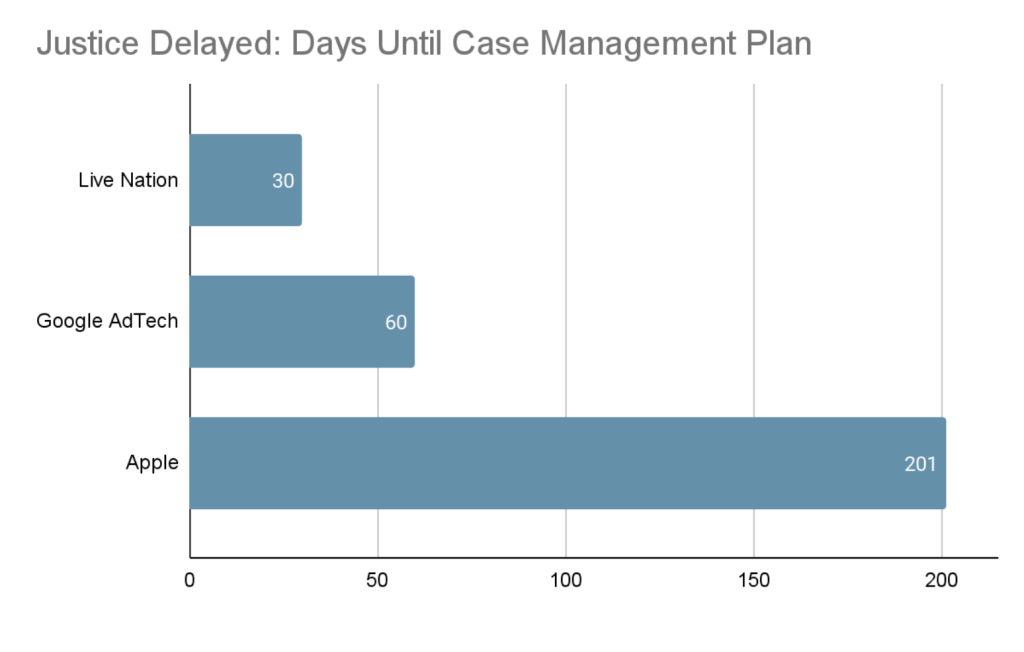Over six months ago, the Department of Justice (DOJ) took bold and decisive action to block Apple’s illegal monopoly and promote fair competition in smartphones and digital services. Since the DOJ brought the lawsuit, the case has been mired by inaction and stall tactics from Apple. With every passing day, the company continues to go unchallenged in perpetuating harm to consumers and innovators. This report compares the process in U.S. v. Apple to similar cases – noting the speed at which the DOJ successfully worked with defendants, like Live Nation and Google, to agree to a case management plan. What makes this different? At its core, Apple’s delay tactics are about gumming up the process and continuing to rake in monopoly profits while justice is delayed.

Case Facts
The Department of Justice’s monopoly case against Apple represents a pivotal moment in the fight for an open internet that is governed by competition and protects American consumers. By addressing Apple’s anti-competitive practices, the Biden-Harris Administration is fighting for a more level playing field that will trigger growth, provide people with greater choice online, and tackle Apple’s tax on the goods and services we buy online.
Rather than focusing on two or three illegal acts, the complaint alleges that Apple engages in a pattern of behaviors that trap consumers into their ecosystem and make it harder to switch, including higher prices and degraded quality.
According to the Justice Department complaint:
- Apple controls how developers distribute and create apps for iPhone users and, in doing so, limits distribution to the Apple app store. This allows Apple to exert monopoly power over developers by imposing contractual restrictions and rules that limit the behavior of non-apple apps and services.
- Apple drives iPhone users away from products and services that compete with or threaten Apple.
- Apple uses restrictions to extract monopoly rents from third parties in a variety of ways, including app fees and revenue-share requirements.
- Apple’s built “moat” around its smartphone monopoly is wide and deep: it uses a similar playbook to maintain its monopoly through many other products and services.
The DOJ complaint lays out five markets where Apple’s illegal monopoly and control over developers have been used to suppress innovation and degrade choice for American consumers.
- Super Apps: Apple prevented apps from threatening its smartphone monopoly by undermining mini programs that reduce user dependence on the iPhone.
- Cloud Streaming Apps: Apple prevented developers from offering cloud gaming apps that reduce dependence on the iPhone’s expensive hardware.
- Cross-Platform Messaging Apps: Apple protects its smartphone monopoly by degrading and undermining cross-platform messaging apps and rival smartphones.
- Smartwatches: Apple protects its smartphone monopoly by impeding the development of cross-platform smartwatches.
- Digital Wallets: Apple restricts cross-platform digital wallets on the iPhone, reinforcing barriers to consumers switching to rival smartphones.
U.S. v. Live Nation (34 Days)
Earlier this year, the DOJ filed an antitrust lawsuit against Live Nation – accusing the company of abusing its market power in the live entertainment industry, resulting in higher prices, diminished services for American consumers, and unfair conditions for artists. Though the lawsuit was brought after U.S. v. Apple was filed, a detailed case management plan is already in place.
Just over a month after the Department of Justice (DOJ) sued Live Nation and Ticketmaster, Judge Arun Subramanian filed a case management plan and set a preliminary trial date. Subramanian’s plan also included a date for a motion to transfer to be filed and estimated dates for the beginning and conclusion of the discovery process.
Timeline:
- 5/24/24: The U.S. government sued Live Nation and its Ticketmaster unit.
- 6/27/24: Judge Arun Subramanian filed a detailed case management plan.
US v. Google Ad Tech (60 Days)
Another comparison point is the DOJ’s monopoly case against Google’s adtech business. That case moved quickly in the United States District Court of Eastern Virginia, known as the “rocket docket.” Just two months after the filing of the initial complaint, a judge ordered the discovery process to begin and laid out dates for the pretrial conference and the trial’s start date.
Timeline:
- 1/24/23: The U.S. government sued Google and its ad business.
- 3/24/23: U.S. Magistrate Judge John Anderson filed a speedy trial schedule and detailed case management plan.
U.S. v. Apple (200 Days and Counting)
In contrast, the DOJ’s antitrust case against Apple is still without a court date or a case management plan. Even with the recusal of Judge Michael Farbiarz, the first judge appointed to hear the case, in April 2024, the Apple antitrust case lags the Live Nation action. On June 27, plaintiffs filed a letter requesting that the court schedule an initial Rule 16 conference to, among other things, address the “scope and timing of permissible discovery.” On July 1, Apple’s lawyers filed a response calling to postpone a Rule 16.1 conference until after there was a ruling on a yet-to-be-filed motion to dismiss.
Timeline:
- 3/21/24: The U.S. government sued Apple
- 4/10/24: U.S. District Judge Michael Farbiarz recused himself from the trial, citing a potential conflict of interest due to financial ties, and Judge Julien Neals is appointed in his place.
- 6/27/24: The Department of Justice requested the court schedule an initial Rule 16 conference to come to a consensus on a case management plan – citing disagreements around the scope and timing of permissible discovery and that the harms were still ongoing. The Department of Justice’s request also proposed the parties provide the court with a joint status report within ten calendar days that lays out places of agreement and dissent.
- 7/1/24: Apple responded by requesting a delay until after the judge had ruled on Apple’s bogus motion to dismiss that had not even been filed yet.
- 7/3/24: The Department of Justice responded to Apple’s objection to a Rule 16 conference – calling it “premature.”
- 8/1/24: Apple files its motion to dismiss.
Conclusion
With over 200 days passed since the Department of Justice brought forward its historic and groundbreaking antitrust case against Apple, justice has been anything but swift. Apple has actively gummed up the process, and the courts have been too slow to react. With every passing day, Apple continues to rake in billions of dollars – obtained because it breaks the law to get ahead. This isn’t a victimless crime. By raising the cost of doing business, illegally locking out competition, and stifling innovators, Apple has cost hardworking families untold sums of money. We believe that the time has come for the judge to lay out a clear and reasonable case management plan so that the American people have their day in court.
